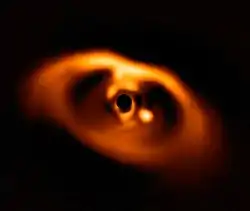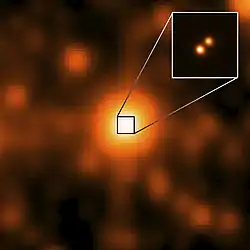Kepler-37d
Kepler-37d is an extrasolar planet (exoplanet) discovered by the Kepler space telescope in February 2013.[4] It is located 209 light years away,[5] in the constellation Lyra.[4] With an orbital period of 40 days,[6] it is the largest of the three known planets orbiting its parent star Kepler-37.[6]
| Discovery | |
|---|---|
| Discovery site | Kepler Space Observatory |
| Discovery date | 2013 |
| Transit | |
| Orbital characteristics | |
| 0.2076+0.0016 −0.0022 AU | |
| Eccentricity | 0.15+0.07 −0.1 |
| 39.79 d | |
| Inclination | 89.335+0.043 −0.047 [1] [2] |
| Star | Kepler-37 |
| Physical characteristics | |
Mean radius | 1.99 [3] R⊕ |
| Temperature | 182 °C (455 K; 360 °F) |
In 2015, a grant was approved to further expand the Sagan Planet Walk by installing a Kepler-37d station on the Moon 384,500 kilometers (238,900 mi) away.[7]
See also
- List of planets discovered by the Kepler spacecraft
References
- http://exoplanet.eu/catalog/Kepler-37_d/
- Barclay, T. et al. A sub-Mercury-sized exoplanet. Nature 494, 452-454 (2013).
- http://saganplanetwalk.wixsite.com/home/kepler-37d
- Black, Charles. "NASA's Kepler discovers small planet system". SEN TV LIMITED. Archived from the original on 23 February 2013. Retrieved 25 February 2013.
- Brown, A. G. A.; et al. (Gaia collaboration) (August 2018). "Gaia Data Release 2: Summary of the contents and survey properties". Astronomy & Astrophysics. 616. A1. arXiv:1804.09365. Bibcode:2018A&A...616A...1G. doi:10.1051/0004-6361/201833051. Gaia DR2 record for this source at VizieR.
- Harwood, William. "Kepler telescope spots smallest exoplanet yet". Spaceflight Now Inc. Retrieved 25 February 2013.
- "Tompkins County Strategic Tourism Planning Board" (PDF). Tompkins County NY. April 15, 2015. Retrieved March 5, 2016.
This article is issued from Wikipedia. The text is licensed under Creative Commons - Attribution - Sharealike. Additional terms may apply for the media files.



